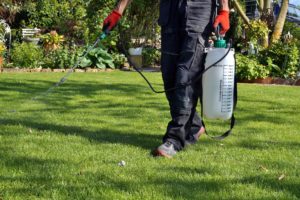
Learn the ins and outs of broadleaf weed control to apply the best care for your lawn.
The presence of weeds in a home lawn mar the appearance of turf, but more importantly, they compete with the desired turfgrass for water, nutrients, light, and space. Control of weeds is not by itself enough because chronically severe weed problems often are symptomatic of a more basic cultural or soil problem. If these problems persist, weeds will be an ongoing problem. Thus, broadleaf weed control not only includes the removal of existing weeds but also taking corrective management measures for the factors causing the poor lawn so that weeds will not become a recurring problem. However, even when employing the best possible management practices, some weeds eventually will encroach into any turf.
Principle Causes of Poor Lawns
Inspection of lawns has shown that one or more of the following factors are typically responsible for poor lawns that result in severe weed problems:
- Poor Quality Seed: Many lawn grass seed mixtures sold in the Mid-Atlantic area contain types of grasses that are not well adapted to the area and/or may contain excessive weed seed. Buy certified seed to ensure that you obtain a quality product.
- Close Mowing: Low mowing greatly favors weed invasion and competition with the desired turfgrass. Insufficient leaf area for developing a robust root system also occurs when the lawn is mowed too closely or frequently. Kentucky bluegrass lawns should be maintained at a height of 2 to 2½ inches, whereas tall fescue and fine-leaf fescue lawns should be kept at 3 to 3½ inches. The lawn should not be taller than 1/3 the desired height before re-mowing. For example, if the desired height is 2 inches, the lawn should be mowed before it exceeds 3 inches.
- Too Little or Too Much Fertilizer and Lime: Various problems arise from incorrect fertilization and liming. Weeds are favored more than turf when fertilizer is applied at an improper time, particularly in the summer—too little fertilizer or lime results in poor turf density and vigor, which decreases competition with weeds. Too much nitrogen fertilizer can increase drought and disease injury, reducing competition with weeds. Soil testing is needed to determine pH and nutrient problems.
- Improper Watering: Frequent and shallow watering usually does more harm than good in lawn maintenance. It increases the chances of disease, restricts the depth of rooting, and encourages the germination of weed seed. When water is needed, apply with a sprinkler and wet the soil to a 4 to 6-inch depth. Never apply water so fast that it stands on or runs off the surface.
- Droughty or Poorly Drained Soils: These soils may not be suitable for growing dense turf. Certain ornamentals or ground covers may be better adapted. However, tall fescue is the preferred species for use in these situations.
- Lack of Sunshine: Many turfgrass species will not tolerate shade; even shade-tolerant grasses grow slowly with insufficient light. If the area receives less than three hours of direct sunlight each day, then the use of certain ornamental ground covers should be considered. Fine-leaf fescues (e.g., creeping red, hard, and sheep fescue) are the best turfgrass species for use in shaded environments. Despite its excellent shade tolerance, roughstalk bluegrass should not be used as lawn grass. Roughstalk bluegrass is highly invasive and will spread to sunny areas where it turns brown in the summer. Eventually, it will spread to neighboring lawns.
- Too Much Traffic: Heavy use of lawn areas or concentrated traffic across one section, particularly when the soil is wet, compacts the soil and weakens the turf. Under these conditions, weeds will be more competitive. Tall fescue is the best lawn grass for heavy traffic areas.
- Insect and Disease Damage: Decreased vigor and thinning of lawns will occur where insect pests and/or diseases are left unchecked. As a result, weeds will rapidly invade damaged areas of the lawn. Tall fescue has fewer insect pest and disease problems when compared to Kentucky bluegrass and perennial ryegrass.
Cultural Control of Broadleaf Weeds
Management and cultural practices greatly influence the numbers and types of weeds found in lawns. Close mowing and too little nitrogen favor nearly all lawn weeds, particularly white clover, spurge, plantains, yellow woodsorrel, and dandelion. Poorly drained areas favor weeds such as ground ivy, chickweeds, and yellow nutsedge, while compacted sites favor knotweed. Correcting improper management practices so that a dense, vigorous turf develops is the best and most lasting method for minimizing broadleaf weed problems. Of particular importance are proper fertilization, mowing, and watering.
Although chemical broadleaf weed control is possible with the proper use of a labeled herbicide, weeds become a recurring problem if poor management and cultural practices are continued. A few broadleaf weed species cannot be controlled satisfactorily by herbicides, so proper management is necessary to reduce the opportunity for their establishment and spread. Once large numbers of weeds have been controlled, vigilant digging or hand-pulling of young weeds as they emerge can effectively keep lawns free of broadleaf weeds for long periods.
Chemical Control of Broadleaf Weeds
In lawns where broadleaf weeds have become a problem, an application of an approved herbicide may be necessary for their removal so that the turf can be improved through better management and cultural practices. Lawn weeds are most effectively controlled when young or immature and during warm (70-85F) and moist periods of late spring (May to early June) and autumn (September to early October). Several materials are available for broadleaf weed control, but different weeds are susceptible to different products. Thus, properly identifying weeds is essential before choosing the most economical and effective herbicide.
Scientific Plant Service Is Your Go-To Source In Landscape Healthcare
Scientific Plant Service, located in Baltimore, is a privately owned corporation, chartered in Maryland in 1957 by Frank J. Burke. We started as a full-service Arborists specializing in the care of shade trees and ornamental shrubs, but today we are a Lawn Care company that is a huge part of the community. From aquatic environments and snow management to deer and mole control, SPS has services tailored specifically for your lawn and landscape.
We offer services in Maryland, Washington, DC, and Virginia, including: Harford, Baltimore, Carroll, Frederick, Howard, Anne Arundel, Montgomery, Prince Georges, Talbot, Queen Anne’s, Calvert counties in MD, as well as Loudoun County, Fairfax County, Arlington, Alexandria, and Falls Church in VA. For more information, contact us online, or call us at 410-321-0970. Be sure to follow us on Facebook, Twitter, LinkedIn, Instagram, and Pinterest.

